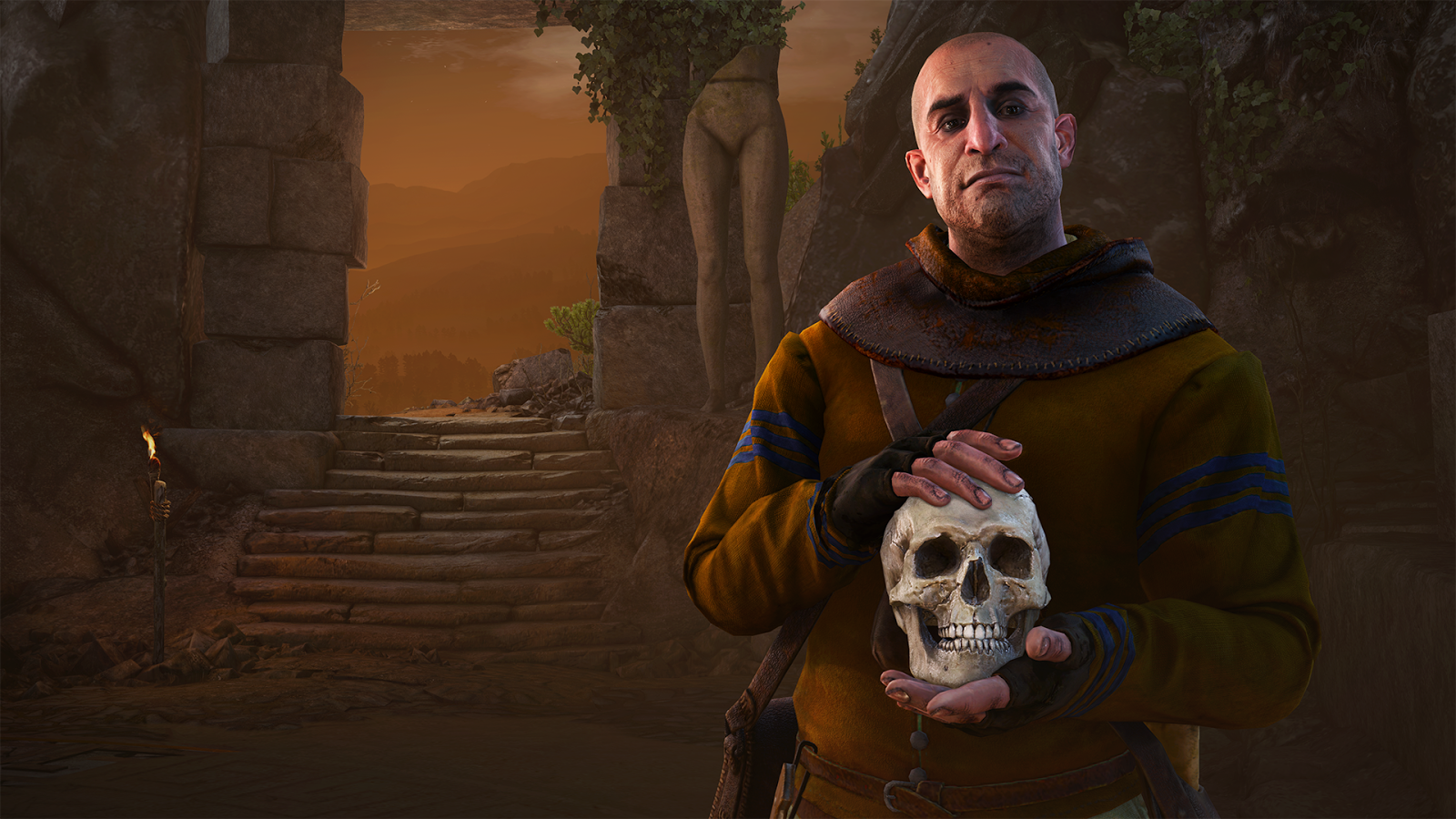Deceit, giant frog monsters, and ghost parties in The Witcher 3's first expansion

[Warning: For those of you intent on playing Hearts of Stone when it releases October 13th, avoid reading. Early spoilers abound.]
During the two hours I spent playing Hearts of Stone, the first expansion for The Witcher 3, I gutted a massive frog, crashed a wedding while possessed by a medieval bro-ghost, and was applauded by a man I decapitated seconds prior. Hearts of Stone impresses with how it skirts around the expectations of typical Witcher quest fare and wraps so many surprising, disparate threads together in such a short time. Two hours is only a piece of the proposed 10, and even though Hearts of Stone is structurally familiar, it feels like The Witcher 3 at its best.
The expansion doesn’t introduce any new playable areas (the second one will), but it still feels like a sizable adventure. Jose Teixeira, a senior VFX artist at CD Projekt, told me Hearts of Stone was largely inspired by the positive reception to long, character-driven quests like The Bloody Baron (one of our favorites). The team wanted to do something in the same vein, but bigger. And without any allegiance to the main quest, it seems they’ve been given room to experiment. The story hits on action, drama, and comedy as expected, but dives deeper into each tenet with a playful confidence.
Old friends
Hearts of Stone opens in the most mundane way it can for Geralt. A notice board leads Geralt on a quest to kill a monster living in the sewers beneath Oxenfurt. The mysterious beast has been catching the interest of the young, unbetrothed masses. Word is, it might be possible for the right person to turn the monster into a man—a prince in particular. Geralt, being the world-weary witcher he is, isn’t swayed by the hopeful implication. A monster is a monster to him. The whole hunt is fun riff on The Frog Prince that throws a few familiar fairy tale tropes at the The Witcher's darker world and mutates. It’s dark alright. And slimy.
Early on, the quest reunites Geralt with an old friend, Shani, who some may recognize from the first Witcher game. Even if you haven’t played the original Witcher like myself, their rapport is portrayed well enough to imply a storied history without getting bogged down in exposition. Shani is collected, cool, and clever. I’m excited to see how she develops.
Shani is in Oxenfurt by way of the Redanian army working as a medic. It turns out the sewer monster produces loads of venom and hasn’t only murdered a hefty amount of innocent romantics and their Redanian rescuers, but has poisoned the water supply. Shani is looking into producing an antidote, so she joins Geralt on the hunt. The search climaxes in a grotesque, gooey fight that, even at level 33, forced me to revisit my arsenal of potions, bombs, and spells to find out what worked. The latter half of The Witcher 3 may have been a breeze, but I died almost right away on my first try and barely scraped by a second time.
Geralt and his spectral foil need to party hard, and fast.
Olgierd von Everec, the man who hired Geralt to kill the monster, was withholding valuable information about exactly why he wanted the sewer monster dead. Avoiding any big spoilers about the quest, Hearts of Stone spins out into an intricately braided plot about old relationships and debts coming to a head. Geralt’s thrown into the eye of the hurricane, a not-quite-so-willing participant in ancient affairs looking for the most begrudgingly utilitarian way out.
Keep up to date with the most important stories and the best deals, as picked by the PC Gamer team.
I’m being intentionally vague, but at the end of my encounter with Olgierd, I was given three seemingly impossible tasks, only one of which I was able to begin to pursue. You’re asked to give a ghost the time of its life, which builds into a wholly comedic venture. Geralt and his spectral foil need to party hard, and fast. The other tasks sound as if they'll be a bit more dramatic in nature, but if what I've played so far is any indication, I shouldn't leap to any conclusions.
New tricks
Hearts of Stone also adds the Runewright, a new type of NPC vendor that has the ability to convert runestones and glyphs into ‘words’ that imbue items with powerful abilities. However, they come with a heavy price. Enchanting any item with a word will block all of its slots and destroy any equipped runes or glyphs. In essence, you sacrifice a few smaller bonuses for a single, powerful bonus.
As pictured above, you can sacrifice your rune slots in a mastercrafted silver sword for the ability to have an armorer’s table and grindstone bonus that never expires. Tempting. I’m not sure how many words a single item can be enchanted with or what kind of diversity we’ll see in the enchant abilities, but it’s a welcome addition anyway. I think players testing their skill in NG+ or harder difficulties will benefit most, as I imagine hardcore players will experiment endlessly to find super efficient loadouts.
Either way, it seems as though tweaking your gear will come in handy on the normal difficulty as well. Within the first hour, I encountered three different ‘boss’ characters with unique movesets, weaknesses, and some pretty powerful attacks. Hearts of Stone may have a narrative focus, but it feels as if CD Projekt is also experimenting with harder combat scenarios after receiving feedback about a fairly flat difficulty curve in the latter half of the base game. During my initial playthrough of The Witcher 3, I became so overpowered I was able to ignore my oils and potions completely. In Hearts of Stone, I was forced to study my enemy, experiment with buffs, and dodge and roll with more precise timing. I just hope the rest of the expansion doesn’t let up.
Heartwarming

CD Projekt VFX artist Jose Teixeria told me that Gwent was actually conceived of during a dev's bath time.
Hearts of Stone’s story still might crash and burn in its latter hours, but given our take on the main game, it’s safe to have faith. I’m also not sure how much the Runewright and new gear will shake things up. I had a good time finding my gear in my initial playthrough of the base game, it just didn’t quite feel like my gear specifically. My hope is that the added variability will give players more room to tinker and personalize so each Geralt plays and looks unique. And it’s important to keep in mind that the issues abound in the base game still persist. Riding Roach is a difficult exercise in horse empathy and the open world is prone to its fair share of strange bugs.
So far, Hearts of Stone feels like a fine balance of action, comedy, and drama—a narrative divorced from the weighty consequence of World Saving™ in the base game, and for the better. Coupled with the promise of new gear, further customization, and some playful, focused storytelling, Hearts of Stone is on track to be a nice deal at $10 when it releases October 13th.
James is stuck in an endless loop, playing the Dark Souls games on repeat until Elden Ring and Silksong set him free. He's a truffle pig for indie horror and weird FPS games too, seeking out games that actively hurt to play. Otherwise he's wandering Austin, identifying mushrooms and doodling grackles.






